Parent Category:
Proximity and Knowledge - Keys to Observation
Did you ever wonder why people disagree about the winners at a dog show? We all have at one time or another, but we know from our experiences that what we think we observed usually depends on many things. At most shows it’s a matter of where you sit or stand during the judging and what you know about the breed standard, structure and movement. Each of these elements tends to influence what we see and think. For example, when a dog is standing, much of its anatomy can be noticed, but when it is gaiting, its movement is often quicker then the eye. In the confined space and limited time allowed in the show ring, even the educated eye that knows what to look for can be misled. In the ring, many things are happening at the same time. Since dogs can move in different ways, where we position ourselves will determine which part of the judging we will see. It might only be the sidegate or perhaps the down and back, or maybe just the individual examination.
The Value of Knowledge:
In addition to being in the right place, what we know about the breed standard and how it is interpreted is paramount to the process. While most of the important faults and virtues are discussed in a breed’s standard, the degree of severity and the frequency of their occurrence vary from dog to dog and from breed to breed. Thus, knowing what to look for separates those who will appreciate the judging process from those who won’t. This includes knowing how to recognize correct and incorrect structure and movement.
Recently I observed the judging of a small class of three Rottweilers. One had a tail. Given the quality of the competition, the tailed dog won based on its merit. That decision was received with mixed review. What followed was a flurry of letters and emails to the judge from breeders and exhibitors on both sides of the crop and dock issue. Even those who were not at the show were critical of the winner. At another show a few months later I observed an entry of 44 Rottweilers. Sprinkled throughout the classes were several tailed dogs. The quality of the entry at this show was better, ranging from good to outstanding. Again, many opinions were expressed by those present and not present. At this show, no tailed dog won a blue ribbon. When the judging was over, pictures taken and the judge’s book returned to the superintendent’s table, a small group of breeders approached the judge and began their conversation with: "Shame on you". The judge assumed these exhibitors to be the owners of the tailed dogs that did not win. His reply was simple, polite and direct. "I’m sorry, could you be more specific?" They responded, "We all knew you would not put up a tailed Rottweiler. We heard you were told not to put one up and you didn’t. Not one of them received a blue ribbon in any class." When asked where they were during the judging, they pointed to a few chairs midway along one side of the ring. It was not the best place to see the judging, but it was the place they chose to sit. From where they were sitting they were only able to see some of the individual examination and the sidegate.
Most judges understand exhibitor disappointment and most are willing to discuss their placements when time allows. What can make these discussions frustrating is to learn that the observers did not really see the judging or were only near the ring. Too often, some chose to sit at ringside only to become involved in the atmosphere of the show with their friends. When the judging is over, they believe they have seen all of the dogs being judged, but in reality they only observed a portion of the judging. Generally speaking, those who sit in one place the entire day will be limited in what they are able to see. It might be the individual examination or perhaps just the sidegate. Those who stand at the end of the diagonal runner facing the judge will see the down and back, the sidegait and most of the judging. Being in the right location is key to being a good observer. This is why judges move around their ring while judging. If they sat or stood in one place all day, they would limit their ability to see and evaluate the dogs and no one would be happy with the results.
In order to appreciate the dogs and the judging process, one must also develop an appreciation for how movement is analyzed from the three basic approaches used by the judges… coming, going and from the side. During the judging, the educated eye will look for fluidity, efficiency, balance and coordination. Most observers can see poor movement because of its awkwardness and lack of grace. Since most dogs are nearly average in quality, evaluating and ranking them requires a more in-depth understanding of anatomy and the principles of movement. Said another way, many faults and virtues can be seen by observing dogs when they are standing, others during the sidegate. Other faults and virtues can only be seen during the down and back. What can complicate evaluations is the size of the ring, the time allowed for judging and the fact that not all dogs move alike. Variations in structure
will also effect how they put their feet down. Take for example the size and substance of the Bulldog with its low center of gravity and wide front. It will not move like the Saluki with its long legs and muscular body. But no matter what the breed, every dog tries to move forward with the least amount of effort. This is why effortless movement is good movement and anything that detracts from efficient movement is considered a fault, whether it results from injury, breeding, poor structure or bad habits.
All dogs have the same number of bones tied together by the same number of muscles and ligaments. How they are shaped, their weight, size and position determines their structure, body style and proportions. This means that the quality of their movement will depend on their joints and the coordination of their body parts. This is referred to as their "angulation", which is a term that is closely related to another term called "balance". Evaluating angulation and balance involves an understanding of the front and rear assemblies. When the term angulation is used, it generally refers to the angles formed at the hip and shoulder joints, the stifle and the hock. A dog with good angulation tends to have a smoother stride than a less- angulated dog.
The Myth About Shoulder Structure:
In Rachael Page Elliott’s book, Dog Steps, (2001) she stated that when a dog is standing with the forelegs in a natural pose, "the blade sets about 30 degrees off a vertical plane – measured up the scapular ridge- is within normal limits for the average well-built dog. " To prove her point she conducted a study at the Harvard University Museum of Comparative Zoology using special equipment, designed by Dr. Farish Jenkins, did the long standing myth about shoulder structure come to light. Using simultaneous x-ray and fluorescoping equipment she studied dogs moving on a tread mill looking at them dog from the inside out. In collaboration with Dr. Edgar Tucker, former President of the American Veterinarian Association, she continued her research and to everyone’s amazement corrected the long standing myth about shoulder angulation. This special equipment provided new information that showed the 45 degree layback angle of a dog’s scapula with a 90 degree angle at the shoulder joint was nothing more than a myth. What had stood the test of time was found to be incorrect. It had been the theory of McDowell Lyon who perpetuated the idea in his treatise on dog structure and gait, in his book, The Dog in Action (1950). Others who supported the theory of a 45 degree layback angle of the shoulder was another noted figure, Max von Stephanitz a distinguished breeder, judge and author.
While generally popular, not everyone was not in agreement about the angulation of the shoulder. The earliest recorded challenge to McDowell’s theory came from H.A.P.C. DeGroot, noted Dutch breeder of German Shepherd Dogs. In his book (1944) on canine structure he reported that based on his clinical measurements on more than 1000 dogs, he wasn't able to find dogs with a 45-degree angle of the blade or a 90-degree angle at the shoulder joint. What he found was a 30-degree angle off the vertical and the angle of the lower blade with the upper arm to be between 108 and 115 degrees, not the 90 degrees that had been shown in so many diagrams similar to the illustration in Figure 1.
Figure 1
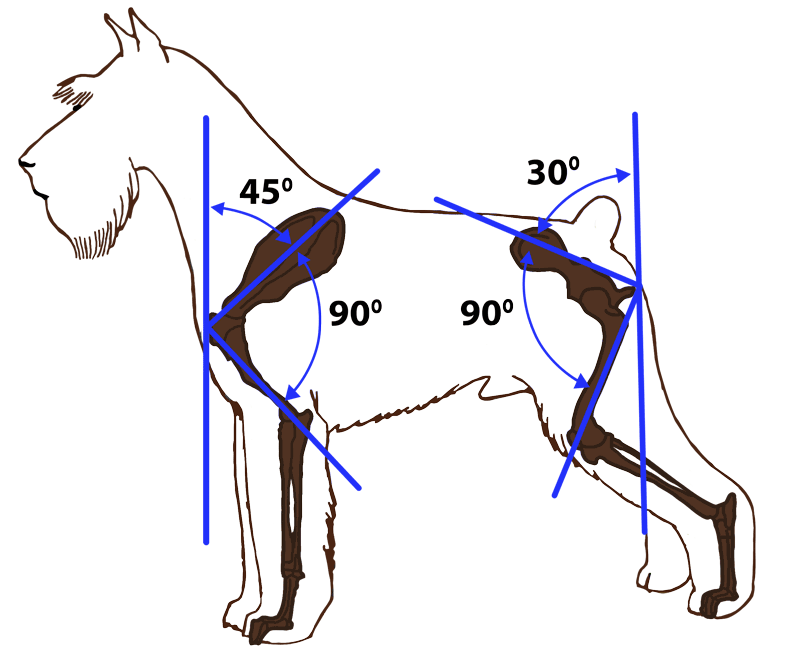
Elliott’s study was different from DeGroot’s. She used a new technology called cinefluoroscopy or cineradiography. Her findings showed that the correct explanation for shoulder structure was a 30 degree layback angle of the scapula with a 108 to 115 degree angle at the should joint. Both DeGroot and Elliott reached their conclusions based on two different approaches.
Balance and Movement:
The term balance is taken to mean the relative proportion of the parts to each other. In observing dogs in motion, judges look for the key elements of gait, remembering that dogs move in different ways and at many speeds. When walking, three feet will touch the ground as the dog moves forward. This can be seen as a regular sequence, right front, left hind, left front, and right hind and so on. As speed increases the dog moves into a trot and the sequence changes. At this point, some will begin to pace. This is a two-beat diagonal gait that occurs when both legs on one side of the body move as a pair. It is a lateral gait which is influenced by the relative length of the back to its height. Pacing can also be caused by injury, fatigue or poor structure.
Being a good observer can also be complicated by the restrictions and limitations of the handler and the many ways they use the lead. Too often, through intent or lack of attention, a handler can confuse movement. When a dog is strung up on a lead so tightly that its feet barely touch the ground, or when it is pulling and straining on the lead, movement can not be evaluated. Handlers sometimes think that faster is better, but speed rarely improves movement, and often it only accentuates a fault. For example, dogs that have a short upper arm will tend to lift rather than reach as their as speed increases.
Foot timing is another term used when observing dogs in motion. The term refers to the proper proportions of the body (height to length) and the coordination of the parts (front, middle and rear). In this regard, judges look for good extension (reach), which means the front feet come out well under the muzzle. They also look for drive from the rear and whether there is stiff and inflexible action of the front, back and hocks. These are the most common faults that influence coordination and balance. During the coming and going, speed will increase from a walk to a trot and the feet will begin to reach toward a center line beneath the body. Both the front and rear legs will appear to fall towards a straight line. This is called the tendency to single track, which is influenced by the height and length of body and leg. Generally speaking, all dogs will show the tendency to single track as their speed increases in order to maintain balance. Several breeds, because of their anatomy, do not, or cannot single tract. They include the double-tracking Corgi and the four-tracking Bulldog.
Another important aspect of judging is the individual examination. This is a time when the judge looks for many of the specific traits listed in the breed standard including breed type which, by definition, refers to the special characteristics that establish a breed’s specific look and unique characteristics. In this regard, four traits are generally used to determine breed type. They include: silhouette, head, color and coat. Each are carefully evaluated using the breed standard. During the individual examination and during the down and back, most judges look for two other key elements of structure. The first involves the leg assembly, which should appear as a single column of support from the shoulder to the ground. When observing the legs, they look for a straight line from the shoulder or hip to the pad of the feet.
<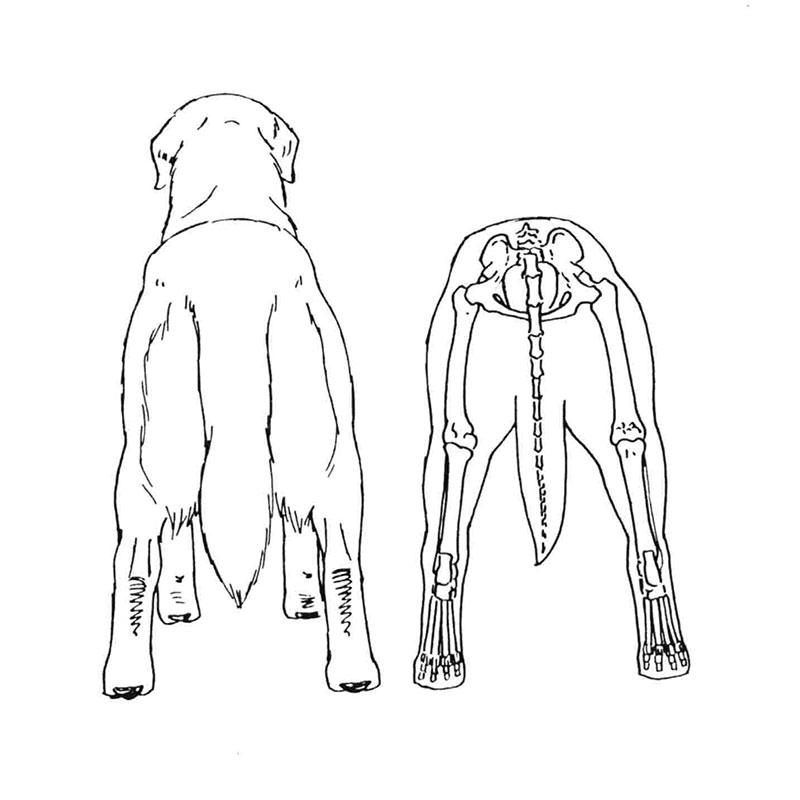
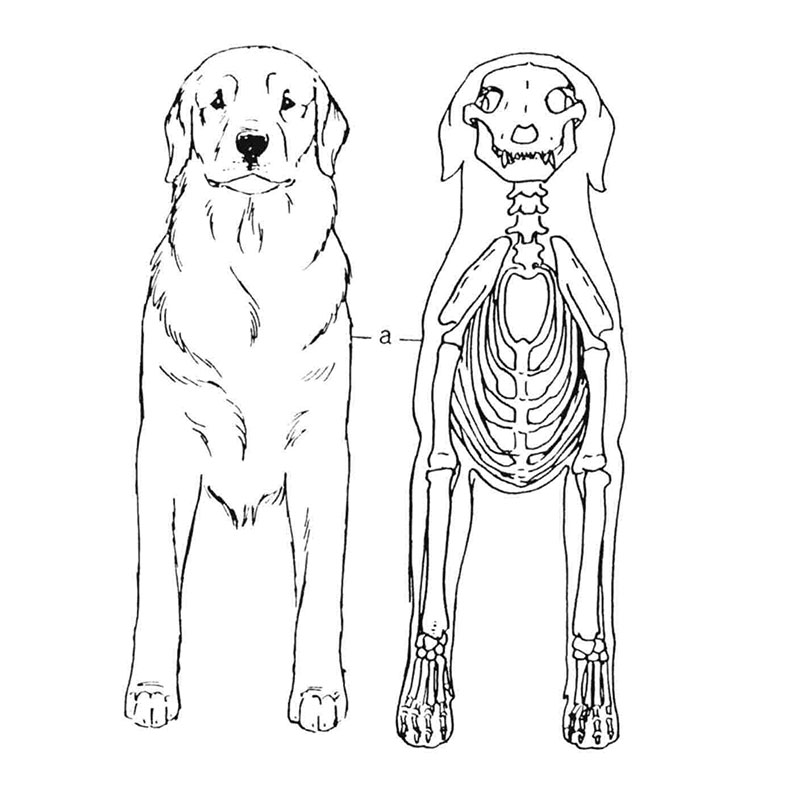
The second key element is evaluated during the down and back. It is called the parallel movement of the legs on the same side of the body. This means that the legs, front and rear, should move in parallel planes. If they are moving in the same plane, the front legs should obscure the rear legs and the hind feet should strike in almost the same place on the same side of the body (see Figures 1 and 2). Another way to think about this is to imagine that the four legs are the four tires on a car as they move forward in the snow. Only two tracks are seen because the front tires obscure the rear tires. When this occurs in the ring, the dog is said to be traveling in the same plane. Any deviation from this principle of the single column of support and traveling in parallel plains is considered a fault. In Figure 1, notice how the front legs obscure the rear legs in the double tracking Corgi and the single-tracking German Shepherd Dog as shown in (Figure 2).
Traveling in the Same Plane
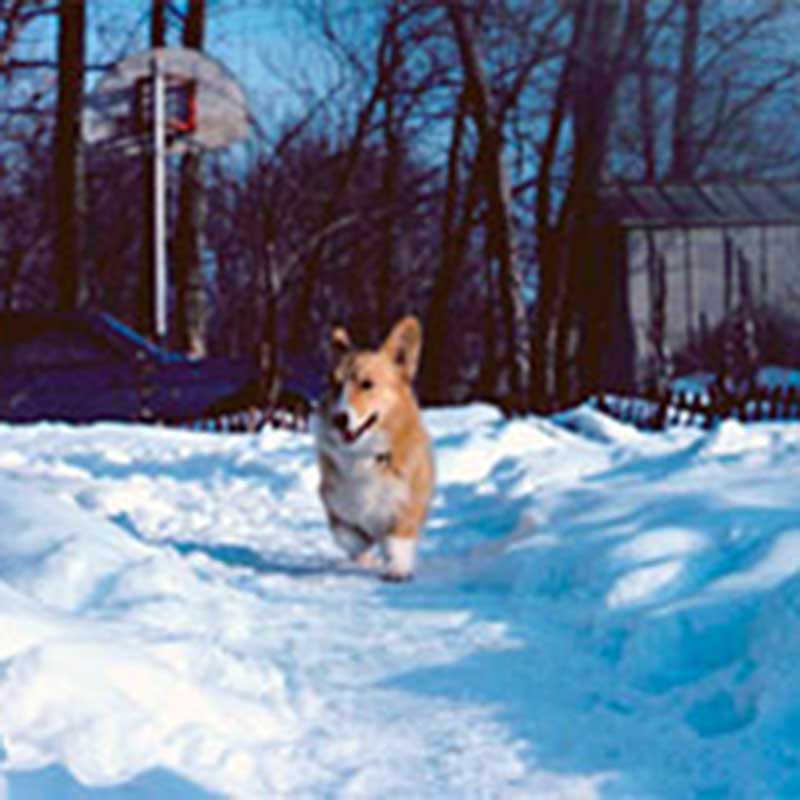
Traveling in the Same Plane
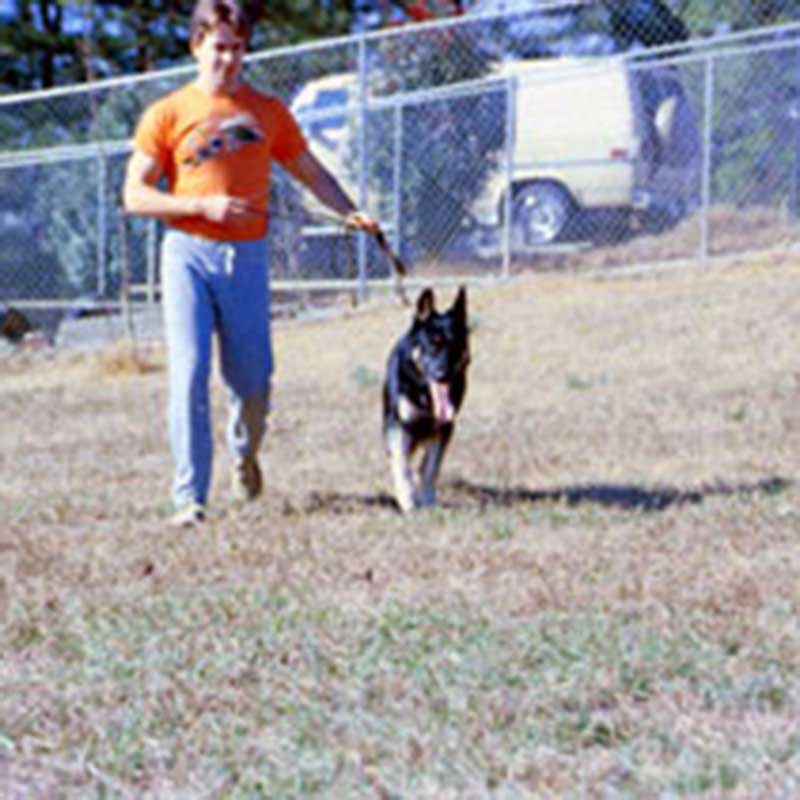
The most obvious cause for deviations from these two key elements will be the lack of proper angulation, balance, loose shoulders, twisting hocks or handlers who confuse the dog’s movement with the lead.
Perhaps the most common fault of movement is over-reaching, which occurs when the rear legs extend so far forward as to pass the front legs. As this happens, the dog is forced to compensate. The most common form of compensation occurs when the dog swings it legs to one side on a bias to the line of travel. This is called "crabbing" or "side winding". It can be caused by a body that is too short for its height or one that has more rear angulation than front angulation or both. Each of these faults results in inefficient movement and contributes to the wasting of energy, which is tiring for the dog.
Conclusion:
While there are many virtues and faults that can be seen during the judging process, some will be more obvious than others. How many virtues and faults one will see during the judging process will depend on ones proximity to the dog, coupled with ones understanding of the breed standard, structure and movement.
Those who do not focus on these principles will miss many of the important parts of the judging process and at the end of the day they may wonder why their final placements are different from those of the judge. When thinking about attending a dog show, there are many factors to consider. When all of the facets as described above are taken together, it seems fair to say that when evaluating the entry at a dog show, there is more to it than meets the eye.
References:
Brackett, Lloyd, and Horswell, Laurence A., "The Dog in Motion", Dog World Magazine, (USA) August 1961- October 1965
DeGroot, H.A.P.C., Translation from Hehonderwereld, 1944
Elliot, Rachel Page, Dog steps, A New Look, Third Edition, Doral Publishing, Sun City, Arizona, 2001 pg 68-73
Foley, C.W; Lasley, J.F. and Osweiler, G.D., "Abnormalities of Companion Animals: Analysis of Heritability", Iowa University Press, Ames, Iowa, 1979
Gilbert, Edward M., & Brown, Thelma R., Structure and Terminology, Howell Book House NY, 1995
Jenkins, Farish A., Jr. The Movement of the Shoulder in the Claviculate and Aclaviculate Mamals, Department of Biology, Museum of Comparative Zoology, Harvard university, Cambridge, MA
Lyon, McDowell, The Dog in Action, Howell Book House, NY, 1950
About the Author
Carmen L Battaglia holds a Ph.D. and Masters Degree from Florida State University. As an AKC judge, researcher and writer, he has been a leader in promotion of breeding better dogs and has written many articles and several books.Dr. Battaglia is also a popular TV and radio talk show speaker. His seminars on breeding dogs, selecting sires and choosing puppies have been well received by the breed clubs all over the country.

